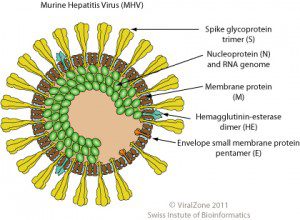

Enveloped viruses such as CoVs typically attach to cell receptors via spike glycoproteins embedded in the viral envelope. To identify the CoV-EMC receptor, part of the viral spike (S) glycoprotein was expressed as a fusion protein with the Fc domain of IgG antibody. The protein was mixed with lysates of cells known to be infected with CoV-EMC, and bound proteins were isolated by using agarose beads bound to protein A (which binds the Fc domain). A single polypeptide bound to the CoV-EMC spike protein was identified as DPP4. Four different lines of evidence indicate that DPP4 is a bona fide receptor for CoV-EMC:
- Soluble DPP4 blocks infection of susceptible cells with CoV-EMC
- Expression of DPP4 in non-susceptible cells renders them susceptible to infection
- Antibody to DPP4 blocks infection of cells with CoV-EMC
- Purified DPP4 protein binds CoV-EMC and inhibits infection
Considering that CoV-EMC was isolated in November 2012 from a sick patient, the identification of the cell receptor is indeed rapid progress.
DPP4 protein is expressed in primary human bronchiolar lung tissue and on primary bronchiolar epithelial cell cultures, consistent with the ability of the virus to infect the respiratory tract. The protein is also present on the epithelium of kidney, small intestine, liver and prostate. CoV-EMC has been detected in the respiratory tract and in urine. Whether the virus replicates in the respiratory tract, and then disseminates and replicates elsewhere (e.g. kidney) remains to be determined.
CoV-EMC is believed to have originated in bats. Consistent with this hypothesis, expression of bat DPP4 confers susceptibility to the virus, although not to the same extent as human DPP4. Once the bat precursor of CoV-EMC is identified, it will be interesting to determine how the viral spike glycoprotein has evolved to enable more efficient usage of human DPP4.
DPP4 is a transmembrane protein that regulates the activity of hormones and chemokines through proteolytic cleavage. The cell receptors for two other CoVs are also membrane-bound peptidases, but proteolytic activity is not needed for infection. A soluble form of DPP4 is also present in blood. The authors speculate that reduction of DPP4 protein levels by CoV-EMC infection could result in higher virus-induced disease. If DPP4 is important in regulating the activity of cytokines – major components of immune responses – their removal from the circulation could result in greater virus replication and more tissue damage. It will be important to study the levels of DPP4 in humans infected with CoV-EMC, and to determine whether levels of the receptor affect viral disease.

Pingback: MicrobiologyBytes » Blog Archive Virology Weekly Newsletter 15.03.2013 » MicrobiologyBytes
Hi Vincent,
On the general subject of this virus, I just read in the Guardian newspaper that the hospital virologist who posted the first report on ProMed, Dr Ali Mohamed Zaki, got fired for alerting the world to this potential threat. Can you believe that?
Story here :
http://www.guardian.co.uk/science/2013/mar/15/coronavirus-next-global-pandemic
Hi Vincent, you say “Whether the virus replicates in the respiratory tract, and then spreads elsewhere (e.g. kidney) via the blood remains to be determined.” how else would get in urine?
I had meant to say that we don’t know if the virus replicates in kidney. Text clarified to reflect this.
Zaki’s sacking is absurd. He did the opposite of what China did when SARS first emerged: tried to hide it. As Martin Enserink wrote in this week’s Science (10 year anniversary of SARS): “Although SARS painfully demonstrated that sweeping an epidemic under the rug is counterproductive, few people believe that this age-old reflex won’t occur again.”
In reality, we didn’t even travel to those boxes until the centre of the fall season.
I sooo want to take a fabulous closer check out some of these memorabilia!
To someone who is convinced those beats head cell phones are worth the income: you have been completely bamboozled. Get a good Sony studio room monitor dj earphones instead.